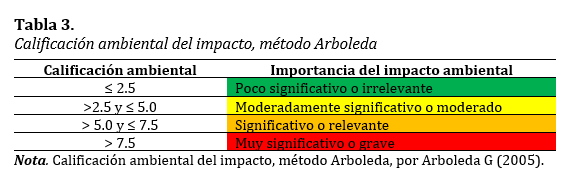Alteration of water quality due to wastewater discharge in the municipality of San Benito, Colombia
DOI:
https://doi.org/10.51252/reacae.v3i1.634Keywords:
wastewater, environmental education, impact assessment, environmental baseline, dischargesAbstract
The study reflects the alterations of the Las Flores water flow in the San Benito municipality, Santander, Colombia, due to the direct discharge of wastewater and the need to formulate alternatives for management, control, mitigation and/or compensation of the impacts generated for this type of waste; The environmental baseline was established, which provides relevant information about the biotic, abiotic and social components. In the same way, the impacts present in the study area were identified and qualified, the characterization of the fixed point of discharge and the receiving source upstream and downstream was continually carried out, in the discharge the obtaining of data such as: biological oxygen demand (BOD), chemical oxygen demand (COD), pH, grease and oils, flow rate, settleable solids , total suspended solids and total coliforms, on the other hand, upstream and downstream, flow data, COD, BOD and pH were collected, these data were compared with the maximum permissible limits established in resolution 0631 of 2015.
Downloads
References
Aguilar Martínez, S., & Solano Pardo, G. A. (2018). Evaluación del impacto por vertimientos de aguas residuales domésticas, mediante la aplicación del índice de contaminación (ICOMO) en caño grande, localizado en Villavicencio-Meta [Universidad Santo Tomás]. https://repository.usta.edu.co/handle/11634/14218
Air Liquide. (2023). ¿Qué es la DQO? – Tratamiento de aguas residuales. Air Liquide. https://es.airliquide.com/soluciones/tratamiento-aguas/que-es-la-dqo-tratamiento-de-aguas-residuales
Arboleda G, J. (2005). Manual de evaluación de impacto ambiental (EIA) de proyectos, obras o actividades.
Arias Nuñez, C. C., & Garavito Carvajal, Z. P. C. (2019). Evaluación del impacto ambiental en los sistemas de tratamiento de aguas residuales domésticas en el corregimiento de Bitaco del municipio de La Cumbre – Valle del Cauca [Universidad Nacional Abierta y a Distancia]. https://repository.unad.edu.co/handle/10596/27903
Beltrán-Vargas, J. E., & Rangel Churio, J. O. (2012). Modelación dinámica de los sólidos suspendidos totales en el Humedal Jaboque, Bogotá (Colombia). Colombia Forestal, 15(2), 191. https://doi.org/10.14483/udistrital.jour.colomb.for.2012.2.a04
Fernández Moreano, V. P. (2019). Diseño y construcción de un sanitario ecológico a través de un biofiltro de bagazo de caña para aguas negras en la Finca Ovina San Pablo de la Parroquia Rural Facundo Vela [Escuela Superior Politécnica de Chimborazo]. http://dspace.espoch.edu.ec/handle/123456789/11136
Fondriest Environmental, I. (2014). Turbidity, Total Suspended Solids & Water Clarity. Fundamentals of Environmental Measurements. Fondriest Environmental, Inc. https://www.fondriest.com/environmental-measurements/parameters/water-quality/turbidity-total-suspended-solids-water-clarity/
Navas Gallo, N. A., & Silva Jaimes, C. (2021). Afectación ambiental por las descargas directas de las aguas residuales sobre fuentes hidricas: Cuadernos Del CURIHAM, 27, 85–91. https://doi.org/10.35305/curiham.v27i.163
Palacin Salcedo, J. J., Tanus, J. L., & López Hoyos, I. D. (2020). Implementación de un sistema natural para tratamiento de aguas residuales en zonas rurales. Estudio de caso para una institución educativa del municipio de Malambo – Colombia. Revista Sennova: Revista Del Sistema de Ciencia, Tecnología e Innovación, 5(1), 92–103. https://doi.org/10.23850/23899573.2382
Rice, E. W., Baird, R. B., & Eaton, A. D. (2017). Standard Methods for the Examination of Water and Wastewater (23rd ed.). American Public Health Association, American Water Works Association, Water Environment Federation. https://yabesh.ir/wp-content/uploads/2018/02/Standard-Methods-23rd-Perv.pdf
Romero Rojas, J. (2004). Tratamiento de aguas residuales. Teoría y principios de diseño (1st ed.). Escuela Colombiana de Ingeniería Julio Garavito.
Tacias Pascacio, V. G., Rosales Quintero, A., & Torrestiana Sánchez, B. (2016). Evaluación y caracterización de grasas y aceites residuales de cocina para la producción de biodiésel: un caso de estudio. Revista Internacional de Contaminación Ambiental, 32(3), 303–313. https://doi.org/10.20937/RICA.2016.32.03.05

Downloads
Published
How to Cite
Issue
Section
License
Copyright (c) 2024 Nelson Andrey Navas-Gallo, Christian Enrique Vargas-Diaz, Luis Miguel Rodríguez-Esteban

This work is licensed under a Creative Commons Attribution 4.0 International License.
The authors retain their rights:
a. The authors retain their trademark and patent rights, as well as any process or procedure described in the article.
b. The authors retain the right to share, copy, distribute, execute and publicly communicate the article published in the Revista Amazónica de Ciencias Ambientales y Ecológicas (REACAE) (for example, place it in an institutional repository or publish it in a book), with an acknowledgment of its initial publication in the REACAE.
c. Authors retain the right to make a subsequent publication of their work, to use the article or any part of it (for example: a compilation of their works, notes for conferences, thesis, or for a book), provided that they indicate the source of publication (authors of the work, journal, volume, number and date).



